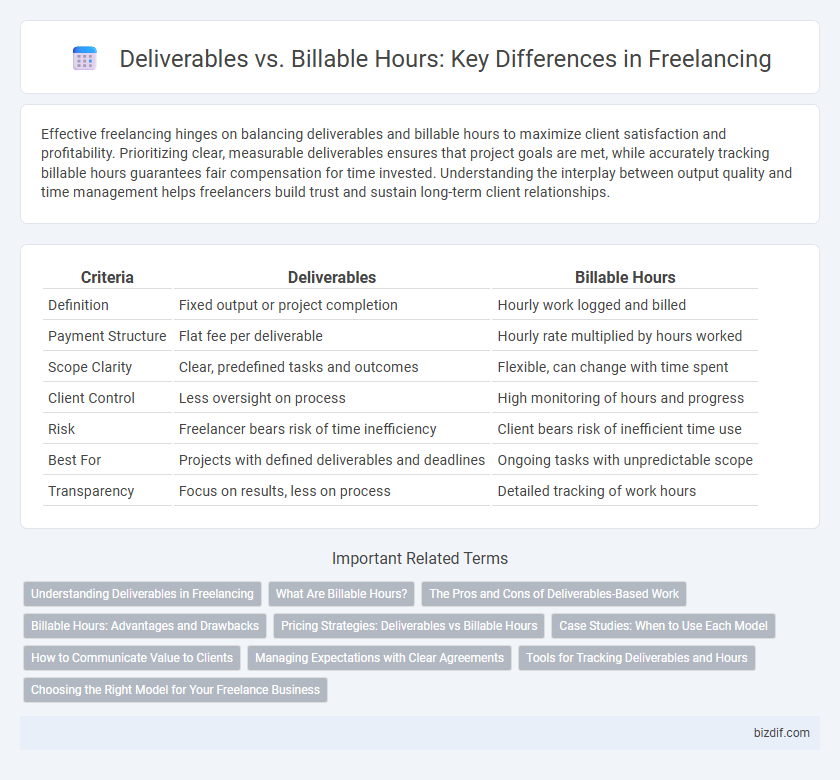Effective freelancing hinges on balancing deliverables and billable hours to maximize client satisfaction and profitability. Prioritizing clear, measurable deliverables ensures that project goals are met, while accurately tracking billable hours guarantees fair compensation for time invested. Understanding the interplay between output quality and time management helps freelancers build trust and sustain long-term client relationships.
Table of Comparison
| Criteria | Deliverables | Billable Hours |
|---|---|---|
| Definition | Fixed output or project completion | Hourly work logged and billed |
| Payment Structure | Flat fee per deliverable | Hourly rate multiplied by hours worked |
| Scope Clarity | Clear, predefined tasks and outcomes | Flexible, can change with time spent |
| Client Control | Less oversight on process | High monitoring of hours and progress |
| Risk | Freelancer bears risk of time inefficiency | Client bears risk of inefficient time use |
| Best For | Projects with defined deliverables and deadlines | Ongoing tasks with unpredictable scope |
| Transparency | Focus on results, less on process | Detailed tracking of work hours |
Understanding Deliverables in Freelancing
In freelancing, understanding deliverables is crucial as they define the tangible outputs promised to clients, distinct from billable hours which track the time spent on tasks. Clear deliverables ensure project expectations are met and facilitate transparency in client-freelancer agreements. Focusing on deliverables rather than just hours helps freelancers align their work with client goals and improves project satisfaction.
What Are Billable Hours?
Billable hours refer to the specific amount of time a freelancer tracks and charges clients for work performed on a project. Unlike deliverables, which represent the completed tasks or final products, billable hours quantify the actual labor spent, ensuring accurate compensation based on time invested. Tracking billable hours is essential for transparency, budget management, and fair billing in freelancing engagements.
The Pros and Cons of Deliverables-Based Work
Deliverables-based work offers clear project goals and fixed pricing, making it easier for freelancers to manage client expectations and avoid disputes over time tracking. However, it can lead to scope creep if project requirements are not well-defined, potentially resulting in unpaid extra work. Freelancers may face risks of underestimation or overcommitment since billable hours are not tracked, impacting profitability and workload balance.
Billable Hours: Advantages and Drawbacks
Billable hours provide freelancers with a clear and straightforward method for tracking time spent on client projects, ensuring accurate compensation and easy invoicing. However, reliance on billable hours may lead to inefficiencies, as freelancers can feel pressured to maximize time rather than focus on quality or outcomes. Balancing billable hours with project value requires careful time management and transparent communication with clients to align expectations and deliverables.
Pricing Strategies: Deliverables vs Billable Hours
Freelancers adopting deliverables-based pricing offer clients clear project outcomes and fixed costs, enhancing budget predictability and reducing billing disputes. Billable hours pricing provides flexibility to capture the full scope of work, allowing compensation for all time spent, but may lead to client concerns over efficiency and escalating costs. Choosing between deliverables and billable hours depends on project complexity, client preferences, and the freelancer's confidence in estimating workload accurately.
Case Studies: When to Use Each Model
Case studies reveal that deliverables-based pricing suits projects with clear, defined outcomes, ensuring clients know exactly what to expect and freelancers are compensated per milestone. Billable hours work better for ongoing or flexible projects where scope may shift, allowing transparent tracking of time spent and adjusting fees accordingly. Selecting the right model depends on project complexity and client preferences, enhancing trust and satisfaction in freelancing engagements.
How to Communicate Value to Clients
Clearly define deliverables to showcase the tangible results clients receive, making the scope of work transparent and measurable. Emphasize outcomes and quality over just billable hours by highlighting how each deliverable contributes to the client's goals and return on investment. Use detailed progress reports and outcome-focused language to demonstrate the value beyond time spent, building trust and client satisfaction.
Managing Expectations with Clear Agreements
Clear agreements outlining deliverables versus billable hours are essential for managing client expectations in freelancing projects. Defining specific project milestones, deadlines, and the scope of work ensures transparency and minimizes disputes over payments. Precise contracts help freelancers maintain professionalism and foster trust by aligning client understanding with actual work output and billing practices.
Tools for Tracking Deliverables and Hours
Effective freelancing requires precise tracking of deliverables and billable hours to ensure transparent client communication and accurate invoicing. Tools like Toggl Track and Harvest offer robust timesheet capabilities, while platforms such as Trello and Asana facilitate detailed deliverable management and deadline tracking. Integrating these tools helps freelancers optimize workflow, maintain project visibility, and maximize revenue from billable efforts.
Choosing the Right Model for Your Freelance Business
Selecting between deliverables and billable hours depends on project scope, client expectations, and your workflow efficiency. Deliverables emphasize clear outcomes and deadlines, ideal for clients valuing fixed results, while billable hours suit dynamic projects requiring flexibility and detailed time tracking. Freelancers optimize income by aligning pricing models with project complexity and client preferences.
deliverables vs billable hours Infographic

 bizdif.com
bizdif.com